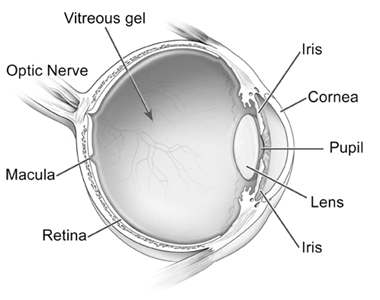| Cataract Surgery and Intraocular Lens Technology |
Background: Cataracts


Definition:
Cataracts form as opacification of the crystalline lens of the eye progresses due to metabolic changes of the lens fibers. At the cellular level, proliferative epithelial cell growth and transdifferentiation lead to up-regulation of alpha smooth muscle actin, leading to protein deposition and "cloudyness" of the lens. The progression of cataract development is most clearly noted by loss of lens transparency, which can be verified with a simple slit-lamp examination.
Initial development of age-related cataract formation may result in myopia with an eventual yellowing and liquification of the cataract cortex (Morgagnian Cataract) of the lens. The lens may ruputure and cause severe inflammation. Untreated, the cataract may progress to cause phacomorphic glaucoma. These advanced forms are characterized by weak zonules prone to spontaneous posterior dislocation. At this point, vision may be completely lost.
Cataract Classification and Development:
1.) Age-related - This is the most common type of cataract. There are three subclassifications, based on location: nuclear, cortical and posterior subcapsular (due to steriod use) or anterior (senile cataracts).
2.) Secondary cataract – Cataracts can reform after surgery due to surgical trauma (aka Posterior capsular opacification: which initiates transdifferention and migration of lens epithelial cells) or other ocular conditions such as glaucoma.
3.) Traumatic cataract - Cataracts can develop after an eye injury due to cell signaling cascades initiated by non-native mechanical cues.
4.) Congenital cataract – A small percentage of children are born with cataracts but not all of these cataracts may advance to impair vision.
5.) Radiation cataract. Cataracts can develop after prolonged exposure to radiation (e.g UV).


Symptoms*:
- Cloudy or blurry vision.
- Colors seem faded.
- Glare or “halo effect” which may appear around sources of lights.
- Poor night vision.
- Double vision or multiple images in one eye.
- Frequent prescription changes in your eyeglasses or contact lenses.
* It should be noted that these symptoms do not always indicate cataract formation, considering that many ocular dysfunctions share similar symptoms (e.g. macular degeneration, glaucoma, retinopathy, etc.)
Diagnosis and Detection:
- Standard ophthalmic exam, including slit lamp examination
- Ultrasonography of the eye in preparation for cataract surgery
Other tests that may be implemented include:
- Glare test
- Contrast sensitivity test
- Potential vision test
- Specular microscopy of the cornea in preparation for cataract surgery
Treatment:
Generally, pharmaceutical agents and changes in diet/lifestyle have not been shown to significantly reduce the onset or progression of cataract formation. Thus, surgical means are applied through either 1.) phacoemulsification or 2.) extracapsular surgery for the implantation of an intraocular lens. These procedures and the accompanying surgical BME devices used are discussed here.
All Right Reserved © 2007 by H Sin